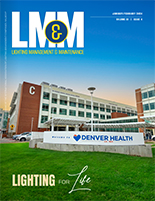Silver Spring, MD—The 36th annual High-Benefit Lighting Awards Program is now underway. Sponsored by the National Lighting Bureau, the unique program is open to owners, architects, engineers, interior designers, facility and property managers, contractors, manufacturer’s representatives, utility employees, users, and virtually anyone else associated with a new or upgraded illumination system that provides at least some of the many benefits of what the Bureau calls High-Benefit Lighting.
The Bureau coined the term High-Benefit Lighting to denote “function-focused” electric-illumination systems that are designed to fulfill the specific purposes for which they will be used, especially to maximize bottom-line returns for those who own, manage, and/or rely on the lighting. For example, High-Benefit Lighting installed in workspaces can help people work faster, because the installation comprises electric illumination designed for the specific space, tasks, and people involved. Just a 1% productivity improvement can save an employer $300 annually for each worker paid $30,000 per year. The cost of the electricity that the employer buys to provide electric illumination to such an employee? Probably less than $50 each year.
Outdoors, High-Benefit Lighting can help prevent accidents of all types, from vehicle-vehicle to slip-and-trip, thus preventing the losses associated with filing insurance claims, absenteeism, administrative paperwork, accident clean-up, negative publicity, and litigation. Fewer accidents can also result in lower insurance premiums. In retail situations, better lighting can help improve customer attraction and stimulate purchasing.
Lighting is also being used for health-care purposes, particularly in senior-care facilities where therapeutic lighting has been shown to offer important advantages.
According to National Lighting Bureau Chair James M. “Jim” Yorgey, P.E., LC, CTS (Lutron Electronics Company), the High-Benefit Lighting Awards Program is “easy to enter. We want to encourage anyone associated with a lighting-system upgrade or installation to submit an application that could lead to our development of a case history chronicling how High-Benefit Lighting contributed to the bottom line. While a system must be energy-efficient to be considered High-Benefit Lighting, the dollar value of productivity improvements, safety and security enhancements, increased retail sales, and other benefits of good lighting typically is far greater than the value of energy savings alone. The dollars saved even by operating and maintenance cost savings of 70% can be dwarfed by the value derived from a productivity increase of just one or two percent,” Mr. Yorgey said.
For consideration in the 2015 High-Benefit Lighting Awards Program, an entry must be received by the National Lighting Bureau no later than October 31, 2015. An entry should document how modification of an existing lighting system or installation of a new one improved productivity, increased retail sales, or achieved any of the many other bottom-line benefits of High-Benefit Lighting.
All persons who enter the High-Benefit Lighting Awards Program receive a hand-inscribed certificate of participation. If Bureau staff develops an entry into a case history, the person submitting the information will serve as the bylined author of an article published in a prominent trade or professional journal.
Established in 1976, the National Lighting Bureau is an independent, not-for-profit, lighting information source. The Bureau’s services – all provided as a public service, free of charge – are 100% dependent upon the funding provided by its sponsors: professional societies, trade associations, manufacturers, and agencies of the U.S. government, now including, among others:
- A.L.P. Lighting Components, Inc.;
- GE Lighting;
- Illuminating Engineering Society of North America (IES);
- Imperial Lighting Maintenance Company;
- interNational Association of Lighting Management Companies (NALMCO);
- International Landscape Lighting Institute;
- Jan & Brooke Luminae, LLC
- Lighting Controls Association;
- LumenOptix;
- Lutron Electronics Company, Inc.;
- Magnaray;
- National Electrical Contractors Association (NECA);
For more information about Bureau sponsorship or its 36th High-Benefit Lighting Awards Program, visit the Bureau’s website (www.nlb.org/awards) or contact Bureau staff at [email protected] or 301/587-9572.



